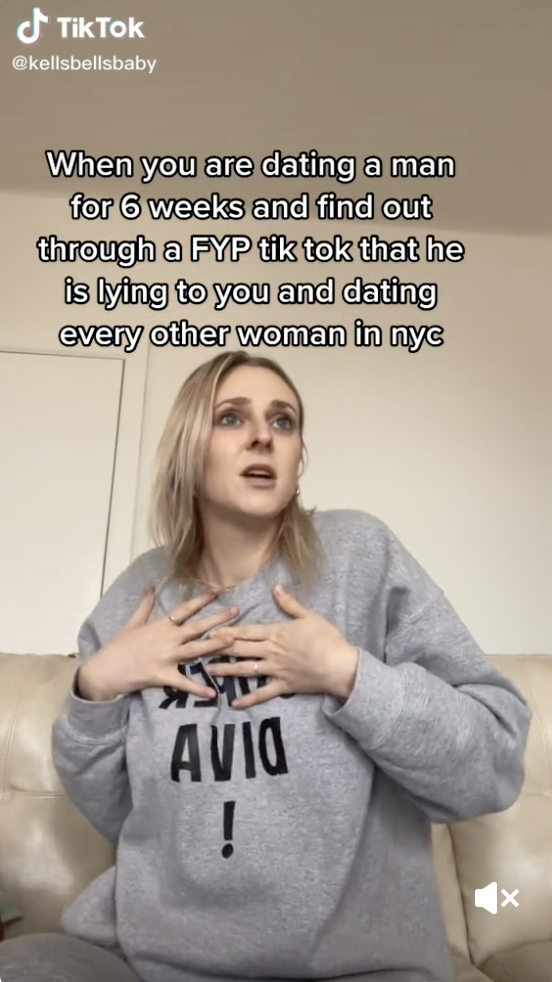
This is an excerpt from Please Like Me, BuzzFeed News’ newsletter about how influencers are battling for your attention. You can sign up here.
This week, TikTok was overrun by the saga of a man whose bad dating history turned him into the new Couch Guy. It’s also a tale of an online mob swarming a private citizen whose crimes didn’t exactly fit the public shaming and reputation-ruining punishment.
A New York woman posted a TikTok about getting ghosted by a guy named Caleb, someone she met on Hinge. Something strange happened in her comment section: Multiple other women replied, “West Elm Caleb?”
It turns out that several women all had similar experiences with the same twentysomething mustachioed West Elm furniture designer they met on the dating app. He had ghosted them after a few dates or texts and did some classic fuckboy moves.
That these women had all found each other was indeed a surprising coincidence (or maybe not, considering that since they were all contacts in Caleb's phone, the platform probably connected them). By Wednesday, “West Elm Caleb” had become a full-on TikTok meme, and women who had matched with him were posting photos of his face. “POV: you’re a mom in SF that just spent an hour deep diving on West Elm Caleb tiktok instead of doing the dishes,” one wrote, noting that she had just found his LinkedIn.
The outrage spilled onto Twitter, and then tabloids and media sites, which published his full name. A rival dating app painted a billboard of his Hinge bio.
People’s reactions were vehement. Caleb’s behavior was predatory and abusive, and he needed to be called out publicly. But did he actually do anything so bad?
Caleb declined to comment on the record for this story.
Here are list of his supposed wrongdoings:
He ghosted people. That’s rude, and even the lunkheads on Love Island know how to politely say “I’m sorry, I’m not feeling a connection.” But this is standard dating behavior.
He allegedly sent at least one person an unsolicited nude photo. That’s gross, and it suggests some lack of respect for women and a lack of understanding about boundaries. But he wasn’t sending it to a coworker or woman friend; it was to someone he was flirting with on a dating app. Context matters. This is bad behavior, but it’s not full-on cancelable, and it’s not even unusual with someone you met on a dating app.
He recycled the same Spotify playlist and claimed he had made it just for them. This is cheesy but funny that he was caught.
He’d “lovebomb,” or show a ton of initial interest over text. Lovebombing is regarded as a precursor to abuse. But there were never any accusations of abusive behavior, he just ghosted.
He lied about his Hinge usage. One woman who went on one coffee date with him said that he told her it was his first Hinge date. He told someone else after a few dates that he had deleted the app.
He played a numbers game: trying to match with tons of people, messaging, and going on plenty of dates but not seeming interested in a relationship.
Lastly, he was dating several women at once. One woman pieced together that she had slept over at his place on a Friday night, woke up there on Saturday morning, and that another woman on TikTok met him for a date later that night.
I’m sorry but, like…we’re all grown-ups here, right? If you’re shocked by the idea of a young single person in NYC having sex with more than one person they’re casually dating, there’s a whole TV show from the 2000s I’d love you to check out. It’s got really great outfits.
Caleb got away with a lot of bad behavior because he’s cute and tall. He is clearly a bad dater, and he evidently did some disrespectful stuff to the women he was talking to or going out with. We shouldn’t just excuse men for being jerks; we should be able to expect more from them. I agree!
But the punishment does not fit the crime. For ghosting a few dates, he has received a brutal internet pile-on that would make Tucker Carlson want to crawl into bed for a week.
Maybe it’s because I’m a child of Rihanna forged in the fires of chaos but what…is so special about West Elm Caleb? Men text you Spotify playlists then ghost you everyday! Explain to me like I’m 5 pls
Something got out of hand, fast.
In 2013, Justine Sacco tweeted an offensive joke about the AIDS epidemic in Africa before boarding a long flight. While Sacco was in the air, her tweet hit a viral outrage cycle. Sacco lost her job and gained overnight infamy. In hindsight, she was a victim of that moment in Twitter culture, where it felt like a daily outrage machine that needed fresh meat to chew up each day. She was a case study about the consequences of online mobs for Jon Ronson’s book So You’ve Been Publicly Shamed.
A few slow news days before the Jan. 6 Capitol assault last year, the internet was transfixed by Bean Dad, a podcaster who tweeted what he thought was a funny story about refusing to show his daughter how to use a can opener. Twitter exploded in rage that this was child abuse. After days of Bean Discourse, the country’s attention turned to something much more pressing.

To some degree, Twitter has gone through several cycles of debating about what it means to get the pitchforks out and make someone the Main Character. There’s some consensus about worthy targets having some form of power, or at least being a public persona (exceptions can be made for incidents of horrifying racism, like the story of Central Park Karen).
But TikTok as a culture hasn’t gone through that process yet. We’re collectively not totally sure what “TikTok culture” is if we’re not talking about D’Amelio dancing videos. This is new ground. One of the OG women who'd posted about Caleb later followed up on Thursday asking for people to not dox him, but it was too late. Even at a product level, TikTok isn’t designed for conversation; replies and follow-ups are hard to find.
The scale and proportions of TikTok virality have always given me vertigo. Things get sucked into some mysterious For You page where you’re shown content that TikTok chooses for you. There are TikTok stars who build a steady following, but a lot of what people see is one random nonfamous person with a single video that blows up.
What started with a John Tucker Must Die moment of women’s empowerment — women looking out for each other! — quickly morphed into something sinister and ugly. I don’t think we’ve fully grasped exactly what the power of a TikTok mob, fueled by a For You page instead of a retweet, can do.
